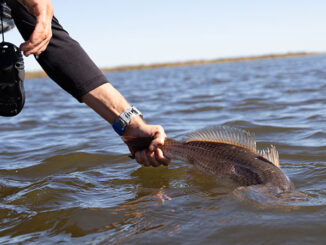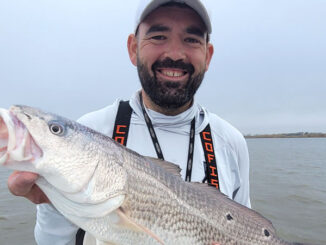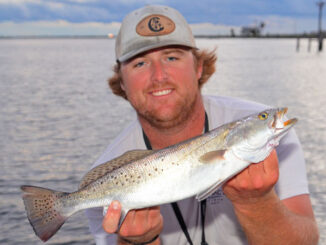
Ho! Ho! Ho! Tis the season to be jolly — right?
Maybe not this year, at least not in our outdoors.
Come Christmas Eve when Santa is coursing over our fields, rivers, bayous, swamps and marshes, it’s not likely he’ll recognize Louisiana.
We’re supposed to be wet. We’re not and duck hunters, even fishermen, are feeling the pinch of extraordinarily low rainfall.
We’re supposed to be green and lush even in late fall and winter — well, at least some green and a dash of lush. We’re not.
There’s a lot of brown around, all of which will add even more gloom to “The Dead of Winter.” It’s not my most wonderful time of the year.
Added to all this are the new speckled trout regulations, 15 fish a day measuring 13-20 inches long with only two among that 15 in the creel allowed to be longer than 20 inches.
And, coming this month, the probability of wrangling over proposed redfish regulations, which, if no action was taken by state legislators, would reduce the take on reds to three a day measuring 18-24 inches with none allowed over the 24-inch barrier.
It’s puzzling
“Probability” is the key word here, if only because nothing can be done in our state easily. Everything, every species serves as a battleground, but this redfish thing is puzzling.
Redfish are our state’s only saltwater gamefish, which means it’s solely for recreational anglers. Redfish are just like bass, sac-a-lait (OK, white perch) and sunfishes. All are banned for commercial take and sale.
So, the discussion of a decreased redfish take boils down to recreational user groups, mostly the rod-and-reel guys versus fly rodders, the latter group gaining support for reduced limits from out-of-state groups who apparently believe they know more about redfish than we do.
From here, those non-Louisiana folks appear to be jealous, as if anyone should be allowed to keep as many fish as we are allowed.
These are curious folks, who ask about fishing in Louisiana, and that they’ve heard how good we have it, all the while knowing how bad they have it, especially those living in coastal states.
They come close to choking — yes, they sputter — when you tell them we could go to the coast and catch 30 or more fish of varying species on a good fall and winter trip, a time when most of them could only lay snuggled up next to a warm fire.
Yep, they’re jealous.
For years, the redfish regs were five a day, keepers measuring 16-27 inches long with one allowed more than 27 inches.
The original redfish-reduction proposal came from Department of Wildlife and Fisheries biologists in August — a move to a “slot” limit of 17-27 inches with a four-fish daily take with a further to eliminate keeping one redfish over 27 inches long.
Partly cloudy
For some among us, even decision makers, there appeared to be some confusion when it came to first dealing with speckled trout for four years, then having a possible reduction in our redfish take. The trout issue appeared to cloud the redfish issue.
Why? Well, it’s because the 5-6 year recovery plan for speckled trout appeared to be so much quicker than the 30-year redfish recovery management plan offered by state biologists.
Confused?
Consider this. A speckled trout’s lifespan is 7-8 years, tops, while a redfish can live up to 50 years.
What’s more, state biologists consider speckled trout to be “overfished” and undergoing “overfishing,” while redfish are not overfished, but, are undergoing overfishing.
Need help? Don’t write a letter to Santa. He doesn’t know for sure, either.
Overfished: The spawning-age population of a species is below what biologists consider to be the minimum level established to sustain and grow the population of that stock. So, action is needed to rebuild the population to, or above, a specific “target level” for that species to sustain a “healthy” population. Simply stated, there are not enough spawning-sized fish to sustain a stock above a minimum level established for the species.
Overfishing: fishing mortality rates are too high to maintain a healthy breeding stock size. Fishing mortality is one factor. So are predation and natural mortality, but catch rates can be controlled and that’s why. The new regulations on speckled trout and redfish (whatever those might be) is to control those “catch rates.”
One more definition
In the case of redfish, it’s to allow more fish to move from juvenile status to breeding stock, a move biologists call “escapement.”
Now, it’s clear. Right? Or do you need one more cup of eggnog?
Most one-year-old female speckled trout are ready to lay eggs and join in reproducing the species. For most female redfish, it takes five years.
Big difference, right?
So when it came time for Wildlife and Fisheries Commission members to discuss redfish, and a 30-year recovery plan was mentioned, a shock wave hit — commission member Joe McPherson said most in the meeting room would be dead before that recovery period was complete.
So here came the 18-24 inches, three-fish plan as an offering. Wildlife and Fisheries marine biologist Jason Adriance said data showed that move would reduce recovery to 11 years.
“The (redfish) stock is not below the limit or target, but it is trending down and has been trending down for a while,” Adriance said. “If we do not get escapement, then the spawning stock biomass will bottom out.”
Stay tuned. And oh, by the way, Merry Christmas! Ho Ho Ho!


